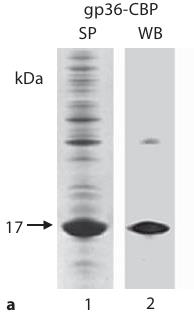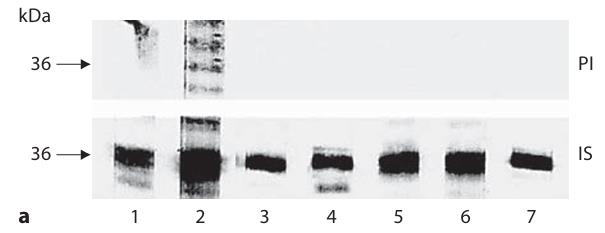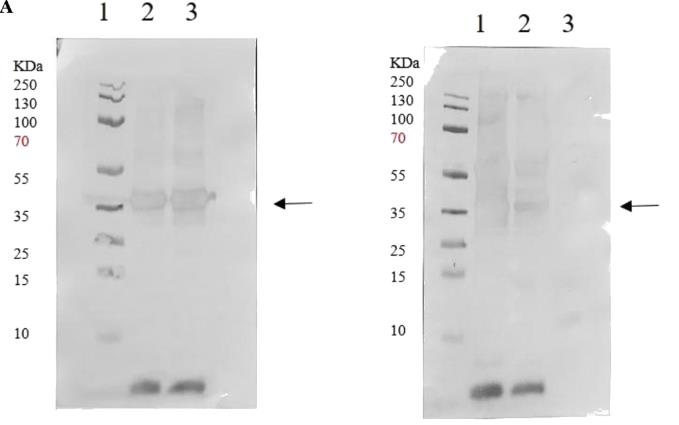Recombinant HIV gp36 protein(Gln547-Tyr670), His&MBP-tagged
| Cat.No. : | gp36-317H |
| Product Overview : | Recombinant HIV-2 envelope glycoprotein gp160 (BAM76170.1)(Gln547-Tyr670), termed as gp36, was expressed in E. coli with the N-terminal polyhistidine tag followed by a MBP tag. |
- Specification
- Gene Information
- Related Products
- Case Study
- Application
- Download
| Species : | HIV |
| Source : | E.coli |
| Tag : | His&MBP |
| Protein Length : | Gln547-Tyr670 |
| Form : | Lyophilized from sterile PBS, pH 7.4. Normally 5 % - 8 % trehalose, mannitol and 0.01% Tween80 are added as protectants before lyophilization. |
| Molecular Mass : | The recombinant HIV-2 gp36 consists of 524 amino acids and has a predicted molecular mass of 58.8 kDa. The apparent molecular mass of the recombinant protein is approximately 55 KDa in SDS-PAGE under reducing conditions. |
| Purity : | > 90 % as determined by SDS-PAGE |
| Storage : | Samples are stable for up to twelve months from date of receipt at -20°C to -80°C. Store it under sterile conditions at -20°C to -80°C. It is recommended that the protein be aliquoted for optimal storage. Avoid repeated freeze-thaw cycles. |
| Reconstitution : | It is recommended that sterile water be added to the vial to prepare a stock solution of 0.2 ug/ul. Centrifuge the vial at 4°C before opening to recover the entire contents. |
| ◆ Recombinant Proteins | ||
| gp36-526 | Active Recombinant HIV-2 gp36 protein, His-tagged | +Inquiry |
| gp36-524 | Active Recombinant HIV-2 gp36 protein | +Inquiry |
| gp36-317H | Recombinant HIV gp36 protein(Gln547-Tyr670), His&MBP-tagged | +Inquiry |
| gp36-47H | Recombinant HIV2 Envelope gp36 Protein | +Inquiry |
| gp36-48H | Recombinant HIV2 Envelope gp36 Protein | +Inquiry |
Case 1: Behrendt R, et al. Intervirology. 2012
To really halt HIV, creating a vaccine that prompts neutralizing antibodies is vital to block the virus from embedding itself into our cells. Researchers have identified antibodies like mAb 2F5 and mAb 4E10 in people with HIV-1 that target stable parts of the virus's gp41 envelope protein. Yet, getting a vaccine to naturally produce these antibodies has been quite a challenge. Meanwhile, for HIV-2, these types of antibodies haven't been found yet. In experiments, scientists made two recombinant proteins based on the HIV-2 gp36 protein and injected them into rats to see if their blood developed antibodies. While the rats did produce antibodies that could attach to the protein, those antibodies couldn't stop the HIV-2 virus itself. Interestingly, these antibodies latched onto a part of gp36 similar to where mAb 4E10 binds on gp41 in HIV-1, giving researchers something to investigate further.

Fig1. SDS-PAGE (SP) and Western blot (WB) analysis for gp36-CBP.

Fig2. Western blot of 7 rat sera before and after immunization with gp36-CBP and gp36-His.
Case 2: Kaewmongkol S, et al. Heliyon. 2020
Researchers wanted to see how well antibody tests work for Ehrlichia canis, especially with different strains. So, they made recombinant gp36 antigens from Thai strains and tested them on 21 dogs with E. canis in the acute phase of infection. They used lab-grown E. coli to produce these antigens, which the infected dogs' blood reacted to in Western blot tests. Here two main types of these proteins, gp36 subgroup A and B. In the tests, 5 dogs showed specific IgM, and 20 had specific IgG. Interestingly, 4 dogs had both IgM and IgG, and one only had IgM. This was the first time specific IgM was found in dogs facing an acute E. canis infection. These findings suggest that the gp36 proteins could be helpful in developing tests to differentiate between various stages of E. canis infections.

Fig1. The western blot results on the 6x His – tag protein.
The recombinant HIV gp36 protein is really important for studying HIV, especially the HIV-2 strain. This protein comes from a part of the virus called the transmembrane glycoprotein, and it helps the virus fuse with host cells. It's also a target for broad-spectrum antibodies and drugs. Because the gp36 protein doesn't change much among different versions of HIV-2, it's a strong candidate for treatments that aim to block the virus.
Researchers are diving into how this protein affects the virus's ability to infect and strategies to design vaccines and drugs targeting it. It's been found to prompt a specific immune response, making it valuable for HIV-2 diagnostic tests. It's especially crucial for identifying whether someone has a single infection of HIV-1 or HIV-2, or both since there's little cross-reactivity between these virus types' envelope proteins.
In both research and industry, the recombinant HIV gp36 protein is a big deal. Scientists use it to understand HIV's structure and action, paving the way for vaccines and therapies. It helps analyze virus-cell interactions and immune responses. On the industrial side, it's key for creating tests and treatments to detect and manage HIV better. In short, this protein is essential in the ongoing battle against HIV, from lab studies to developing critical medical tools and solutions.
Not For Human Consumption!
Inquiry
- Reviews
- Q&As
Ask a Question for All gp36 Products
Required fields are marked with *
My Review for All gp36 Products
Required fields are marked with *
Inquiry Basket


